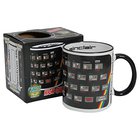Nintendo Famicom Disk System
| Home > Browse Our Collection > Games Consoles > Nintendo > Nintendo Famicom Disk System |
|
The Disk System was released on February 21, 1986 by Nintendo as a peripheral for the Nintendo Family Computer console in Japan. It was a unit that used proprietary floppy disks (called "Disk Cards") for data storage. It was announced, but not released, for the North American and PAL NES Consoles Through its entire production span, 1986–2003, 4.44 million units were sold. The idea behind the disk system was that games could be produced much more cheaply than cartridges, with their multitude of microchips, and circuit and plastic construction, the games were also much cheaper for the public to buy, the disks could also initially hold more data than contemporary cartridges, which the more data they held, the more they would cost. Also booths were created in shopping centres, where gamers could buy and insert a blank disk, and have a game of their choice written to it, these are easy to spot for collectors, as they are blue instead of yellow, there was a reduced cost option of writing a new game on top of an old one. The logo on the bottom of the disk acted as an early deterrent to piracy, it was moulded to fit a pattern inside the actual disk system, if the disk did not sit flat inside the machine if the mould was wrong, then the game would not load. Of course it did not take long for disks to appear that had the whole logo area missing to get round this. The Disk System sat underneath a Famicom or AV Famicom, and was connected to the console with a supplied adaptor that plugged into the cartridge slot. The other end of this plugged into the back of the peripheral. The cartridge held the transfer software, and also a new sound chip. The unit could be run off a supplied PSU, or if short of sockets, six C style batteries could be put into the system, which can last up to a year. Some famous games such as The Legend of Zelda appeared on disk first, due to the larger capacity of the disk, but as costs and technical improvements to cartridges appeared, the extra memory became less crucial, and as cartridges were much harder to copy, this outweighed the need for this expensive peripheral for the Famicom. The machine can be difficult to maintain, the rubber bands perish with age, and then great care must be taken to calibrate the drive after they are replaced, if the mechanism is not aligned properly, it can score and permanently damage the disk. Sharp gained a license to produce an all in one unit that played both disks and cartridges, called the Sharp Twin Famicom. Our model is in excellent unboxed condition, complete with connecting cartridge. Manufacturer: Nintendo This exhibit has a reference ID of CH32257. Please quote this reference ID in any communication with the Centre for Computing History. |
Click on the Image(s) For Detail
|


























